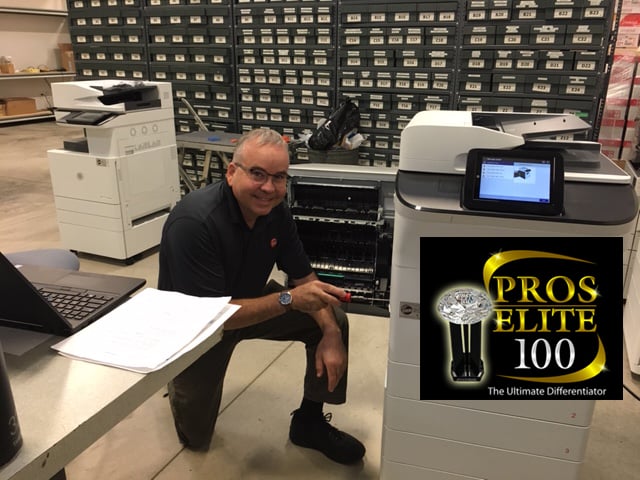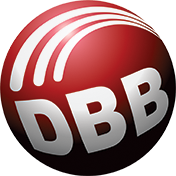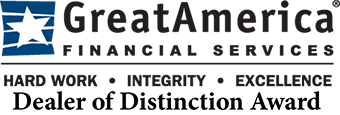
If you have ever been in the situation where you were acquiring office equipment, you have no doubt talked with multiple, competing, salespeople and asked about their service. Interestingly, each one told you that their company provided the best service. You probably heard about response times, maybe even uptime, and probably that they all only use OEM (Original Equipment Manufacturer) parts and supplies.
But what KPI’s (Key Performance Indicators) actually makes up for “good” or even “great” copier service? How do you know who really has great service and who may be really trying hard but just doesn’t deliver?
There is no shortage of KPI’s (Key Performance Indicators) that can be monitored on a daily, weekly, monthly, and ongoing frequency. The top service providers in the industry typically belong to one (or more) of several peer groups where specific benchmarks have been established for every KPI and those companies actively monitor them.
For decades one of the biggest talk tracks for copier salespeople is to talk about “Response Time”. Everyone “guarantees” a 4-hour minimum or 2-hour, or some other number that they don’t actually plan to adhere to, or most of the time, even know if they adhere to. Sometimes a “response” is a call back and not an actual “repair response”. Response time should be tracked based on the time that the servicing company becomes aware of the problem and a qualified, factory certified, technician arrives on site to repair the problem. That is how response time should be tracked and reported.
Response Time is definitely important and is one of the common KPIs. The industry benchmark is 4 business hours. Most of the top companies average less than this number. But response time, in and of itself, is pretty worthless. In today’s networked world, there are some issues where it is possible to remotely repair a system without even having to dispatch a technician. This results in a response and FIX time of mere minutes as opposed to hours. This is why more and more office equipment providers are developing their own call centers and First Touch teams. Not only does it provide quicker, superior service, but it does so without the expense of dispatching a technician and wasting fuel in a vehicle.
FCE (First Call Efficiency) is, in my opinion, a far more important KPI than Response Time. First Call Efficiency is, basically, whether or not the service call was performed properly, and the system was repaired. If every call goes perfectly, then a technician will have a 100% FCE. There are two types of calls that detract from FCE. “Call Backs”, which occur when the original call is closed as complete, but the system fails at a later date resulting in another call before one should be expected (specific time and/or copy count depending on model). The second type is an “Incomplete” call, which is typically due to the technician not having the proper parts needed to repair the system or if they are unable to troubleshoot the problem and need a second set of eyes. The industry benchmark for FCE is 82%, meaning that you should only expect about 1 in 5 calls to not go as planned.
Average Repair Time is another KPI that is closely monitored. The Industry benchmark for the average call duration is 1.2 Business Hours. On average most calls do not take the 1.2 hours. However, the best service companies in the industry adhere to a “Total Call” philosophy, where the technician is required to go over all aspects of the system while they are there, including cleaning and vacuuming the system, even if the original call was for an isolated issue. This helps prevent Call Backs and provides for fewer calls and better copy quality over the life of the system.
Preventative Maintenance Cycles are also important. In every system, there are a set of parts that all have the same copy count/life expectancy. The best companies require their technicians to go ahead and perform a PM on a system that they are servicing even if the PM is only close to being due (not necessarily waiting until it is due). This, again, prevents a future service call and improves the uptime of the system. It is surprising to find that a lot of companies do not actually even adhere to the PM schedule and simply repair each individual part as it fails. This can result in multiple service calls and ultimately can cost the service company more money than had they simply done the job right the first time.
So far we have discussed having a quick response time, fixing the system on the first call (FCE), doing it in about an hour’s time, and making sure that all the parts have been replaced as the manufacturer calls for them. But another key aspect is the person that has to perform this task. Is a new hire that just came out of a couple weeks of training or is it a factory authorized technician with years of tenure? To be sure, a new hire is going to cost a lot less to employee than a fully trained and certified tech with 20 years of experience. The tenured tech will have a higher salary, more vacation time, and other benefits, but should also be far more efficient in both FCE and time. Making sure that your service providers techs are factory trained and certified, drive reliable transportation and have a compliment of parts stock is imperative to having “good” service.
Some other factors that are monitored daily would include such items as Gross Calls Per Technician Per Day, Net Calls Per Technician Per Day (Gross calls less any Call Backs and Incomplete Calls), Technician Accountable Time, Average Travel Time, and Parts Stock Inventory within their service vehicles.
At first glance, you may as a consumer think that none of those KPIs have anything to do with you. After all, you may want the technician to carry 5 of every part ever made so that they always have what they need. Or maybe you don’t care if the technician only takes one call (your call) that day. Does it really matter if he/she hits the industry benchmark of 5 Gross Calls per day? Same thing with Accountable Time. As long as the technician shows up quickly to your call, has the part, repairs it right, and moves on, what does it matter what they do after they leave your office. Right?
Well, all of this comes down to one of the key buying factors that you more than likely evaluated when you acquired the system. Price.
In order for an office equipment provider to maintain above industry level service AND be competitive, then it is important to make sure that the service department is being properly run and that the customer is getting what they pay for. So, what does good service look like?
Good service is when every technician averages 5 gross calls per day, 4.1 net calls per day, and only averages 8% incomplete calls and 10% call backs. Their technician accountable time should be at least 7.5 hours per day, with the average repair time being around 1.2 hours and the average response time being less than 4 hours. All of which provides for quick, responsive and affordable service that results in a First Call Efficiency at or above 82% and provides a minimum “up-time” of your system of 95%. Finally, and not least of all, these numbers should be able to be reported to you, the customer, on demand, for the lifetime of the contract.
A large amount of office equipment providers are not even capable of tracking some of these numbers. Some that are capable, simply don’t. As I have said in other posts, to be the best in this industry requires an exorbitant amount of hard work and dedication. Not only by owners and top management, but by everyone on the entire staff. In order to accomplish these numbers, the top companies utilize GPS monitoring in company vehicles. They provide techs with handheld devices for automated dispatching and call routing. Everywhere outside of major cities, technicians are typically geographically designated which means they need to be cross trained on most every device and carry parts for those devices. But in order to minimize parts inventory, the car stock needs to monitored daily by full time parts coordinators who track the average customer volumes within each technician’s territory and estimates which parts will be needed in the near future using advance algorithms in multiple systems.
Speaking of parts, there is a plethora of third-party parts available for pretty much any and every system made. If you want your office equipment partner to adhere strictly to OEM parts, this will also make it more difficult to properly manage those car stocks and remain competitive. In reality, there are some third-party parts that are significantly improved over OEM. Think about cars for a second. We all know that if you want to boost performance you don’t buy stock exhaust systems or fuel systems or even air cleaners. Copiers aren’t any different. Some third-party parts actually cost more than OEM but last significantly longer and can be more reliable. That said, these parts are the exception and not the rule. The vast majority of OEM parts and supplies is preferred. However, If you have the right office equipment partner, you should trust them to make those evaluations. Understand that the most expensive piece of servicing your account, is dispatching a technician to your account, so using cheap parts and supplies that create additional service calls, is a no-win formula. Also, take into consideration that most office equipment providers carry at least 2, if not 3 or more, manufacturer lines, and consider that it isn’t just copiers. There are printers, faxes, wide format devices, scanners, shredders, and believe it or not…an occasional typewriter. This turns parts management almost into a necessary science.
All of this is just half of what goes into servicing your systems. There is also the administrative aspect which includes accurate billing, on-time and accurate supply fulfillment, automated supply fulfillment, automated meter readings, and so forth. All of these are additional KPIs that should be monitored on a daily, weekly and on-going basis. And in case you are wondering, should all be at or above 97% accuracy. In order to effectively monitor these tasks, there are several industry specific operating systems and software services that must be used. Interestingly, not everyone does use them and therefore have no real way of tracking this information.
So, the next time you are in the market for office equipment, please make sure you inquire about some of these KPIs, and how the prospective company that you are talking to tracks them and if they are able to supply them to you on a regular basis. Getting this information goes a lot further than simply being promised the “best” service or “guaranteed” a specific response time. For more information, check out our blog on Net Promoter Score.

